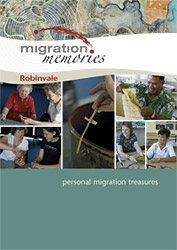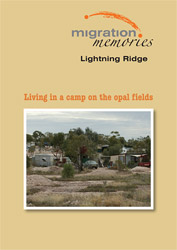Development process
Introduction
This section discusses how components of the exhibitions were developed as part of a collaborative process.
While there are many examples of collaborative development of museum exhibitions that involve curatorial staff working with community participants, it is more unusual to include design professionals in the collaboration. The Migration Memories exhibitions were developed with community participants, the curator, design professionals and photographers. While the project had clear research intentions, the exhibition development process was a responsive one which was open to ideas and developments along the way.
The individual stories
In the first stage of the process the curator worked in detail with the storytellers to develop and select material that would tell their story as they saw it. In Robinvale, where images of objects were used in the display, the photographer also contributed to this stage of story development.
Mary Hutchison, researcher for the project and curator |
Jo Sheldrick, photographer, Robinvale |
 |
|
| Curator Mary Hutchison's mock-up drawing for Kay Grose's Robinvale story. |
In the next stage of refining direction and content, the curator made a mock-up of the way images, text and objects would be used in each story. This made it possible for the story tellers to get an initial visual idea of what would be in the display and to suggest further refinements.
The designer then started to work the refined content into design form. This was a stage of experiments and further refinements in which both curator and designer were involved. Draft designs were shown to the storytellers and their permission was sought to finalise the designs and produce them for the exhibition.
Iona Walsh, designer, Lightning Ridge |
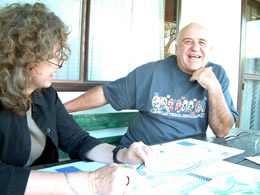 |
|
| Designer Iona Walsh discussing designs with Dusan Malinovic. Photograph: Jenni Brammall. |
The sound installations
The intention of the sound installations was to create a sense of local cultural diversity primarily through the sound of voices, The involvement of local participants was crucial to their success.
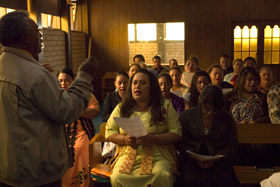 |
Lea Collins, composer and sound designer We were never collecting material from people and taking it away. We were always working with them and wanted them to hear what the whole thing sounded like before it was finalised. I think interest in and respect for people is part of making this kind of work. |
|
| The Tongan Choir, Robinvale, 2007. |
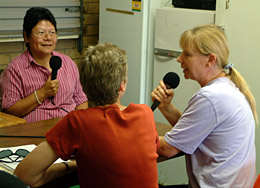 |
|
| Recording session at the Lightning Ridge community radio station Opal FM. Clockwise from front: Mary Hutchison, Dora Garcia and Edith van der Chijs. |
In Robinvale the sound of Tongan choirs was an important element of the local soundscape. The Tongan Christian Fellowship arranged for Migration Memories to record a joint service with the Seventh Day Adventist Church. In return the project provided them with their first CD. In Lightning Ridge people were recorded talking with each other in their own languages and in English.
Exhibition elements that emerged through community participation
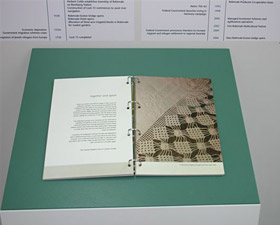 |
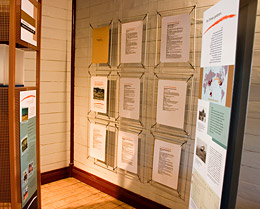 |
|
| Flip book of object images and text developed for the Migration Memories: Robinvale exhibition. Artwork: Paula McKindlay. | Lifestyle surveys on display in the Migration Memories: Lightning Ridge exhibition. Photograph: Ursula Frederick, 2006. |
The collaborative development process in each locality produced exhibition elements that had not been previously considered. In Lightning Ridge, Christina Johansson conducted some ‘lifestyle surveys’ which gave a vivid impression of living on a camp on the opal fields. In Robinvale, a wider exploration of interpreting artefacts of migration through image and text, strongly supported by Regional Arts Victoria and Robinvale Network House, led to the development of a ‘flip book’ for the exhibition. During the process a number of these stories and images were published in the Robinvale Sentinel.
Liz Duthie, Regional Arts Development Officer I think the show and tell sessions broadened out the project and gave other ways for people to be involved – especially through the school. They were a way of bedding the project into the community more deeply. The book was a lasting thing that could go into different contexts. When you see your story in a book, it gives it weight. |
||
| Cover of book of object images and text developed for the Migration Memories: Robinvale exhibition. Artwork: Paula McKindlay. |
Christina Johansson, President of the Lightning Ridge Transcultural Community Council I think the survey collection paints a picture of the people who actually come to Lightning Ridge and the choices they make. I wanted to show the mix of people who live here, not because they have to but because they have made a choice to live out on the opal fields. I didn’t want to be too personal or too imposing. I just asked a few simple questions about why people moved here, what sort of accommodation, water and power supply they have, and their main expenses. That sort of information makes people here think ‘this is us’. And for other people it’s interesting to see. |
The Lightning Ridge surveys were presented as a book at the National Museum exhibition. Design: Iona Walsh. | |

